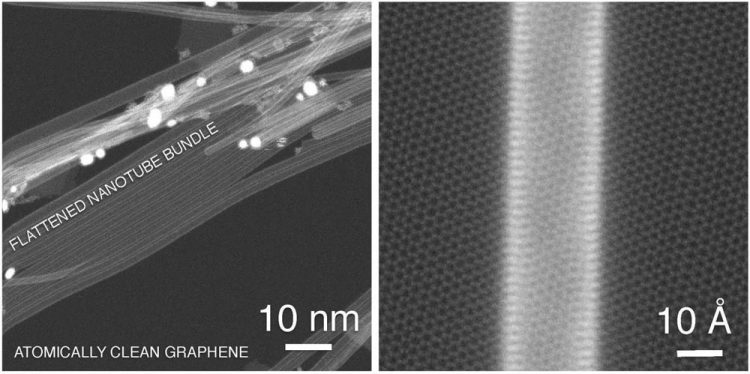Graphene substrate improves the conductivity of carbon nanotube network

LEFT: scanning transmission electron microscope image of single-walled carbon nanotubes on graphene. Due to strong van der Waals interaction, the bundle has collapsed into a wide ribbon. RIGHT: an atomically resolved closeup of an individual tube-graphene interface Credit: Kimmo Mustonen / Jani Kotakoski, University of Vienna
Transparent conductive films (TCFs) have many applications in touch screens, organic light emitting diodes and solar cells. These applications need materials that are strong, energy efficient and stable, which is why companies and researchers are interested in carbon-based materials. This applies especially to networks of single-walled carbon nanotubes, which are expected to replace the metal-oxide films that are currently used.
Graphene is the thinnest imaginable material, it is just one atomic layer of carbon atoms. Rolling this into a cylinder makes a carbon nanotube, which is better suited to carrying electricity in real-world applications.
In an article published in ACS Nano, scientists at Aalto University and the University of Vienna introduce a hybrid material made by combining carbon nanotubes and graphene, which improves the conductivity of the film beyond what is possible when using each of these component structures separately.
Professor Kauppinen's group at Aalto has years of experience in making carbon nanotubes for TCFs. This new work applies the techniques they have developed to place densely-packed and clean random nanotube networks on graphene. “This is another application of the technologies we have developed over the past decades. Put simply, this work is about how the two materials are put together without solvents,” Kauppinen explains.
In the study, the scientists used a process called thermophoresis to deposit nanotubes on prefabricated graphene electrodes. The hybrid films' conductivities were roughly twice as high as predicted.
The experiments conducted by the team at the University of Vienna, led by Jani Kotakoski, showed that the strong electrical interactions of graphene enhanced the flow of electrons between the nanotubes by encouraging charge-tunneling.
The team used a scanning transmission electron microscope to look at the material on the scale of individual atoms, and saw that the van der Waals interaction between the graphene and nanotubes was strong enough to collapse the circular nanotube bundles into flat ribbons.
The lead scientist from the Vienna group, Kimmo Mustonen, explains: “This is really an ingenious approach. The charge transport in nanomaterials is very sensitive to any external factors. What you really want is to avoid unnecessary processing steps if your goal is to make the ideal conductive film.”
Mustonen adds, “It actually is quite remarkable. We of course knew that the interaction is quite strong. For instance, think of graphite; it is just a large number of graphene layers bound together by the same mechanism. Yet we did not expect that it has such a strong impact on conductivity.”
The results provide opportunities to improve the conductivity of similar hybrid nanomaterials. The article was published in “ACS Nano” in September 2019.
Media Contact
More Information:
http://dx.doi.org/10.1021/acsnano.9b05049All latest news from the category: Materials Sciences
Materials management deals with the research, development, manufacturing and processing of raw and industrial materials. Key aspects here are biological and medical issues, which play an increasingly important role in this field.
innovations-report offers in-depth articles related to the development and application of materials and the structure and properties of new materials.
Newest articles

First-of-its-kind study uses remote sensing to monitor plastic debris in rivers and lakes
Remote sensing creates a cost-effective solution to monitoring plastic pollution. A first-of-its-kind study from researchers at the University of Minnesota Twin Cities shows how remote sensing can help monitor and…

Laser-based artificial neuron mimics nerve cell functions at lightning speed
With a processing speed a billion times faster than nature, chip-based laser neuron could help advance AI tasks such as pattern recognition and sequence prediction. Researchers have developed a laser-based…

Optimising the processing of plastic waste
Just one look in the yellow bin reveals a colourful jumble of different types of plastic. However, the purer and more uniform plastic waste is, the easier it is to…



